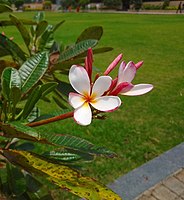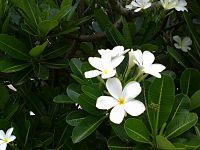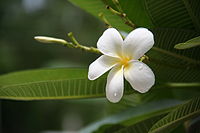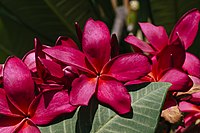Plumeria
Plumeria (/pluːˈmɛriə/), also known as frangipani, is a genus of flowering plants in the subfamily Rauvolfioideae, of the family Apocynaceae. Most species are deciduous shrubs or small trees. The species are native to the Neotropical realm (in Mexico, Central America, and the Caribbean, and as far south as Brazil and as far north as Florida in the United States), but are often grown as cosmopolitan ornamentals in tropical regions, especially in Hawaii, as well as hot desert climates in the Arabian Peninsula with proper irrigation.
| Plumeria | |
|---|---|
 | |
| Plumeria rubra | |
| Scientific classification | |
| Kingdom: | Plantae |
| Clade: | Tracheophytes |
| Clade: | Angiosperms |
| Clade: | Eudicots |
| Clade: | Asterids |
| Order: | Gentianales |
| Family: | Apocynaceae |
| Subtribe: | Plumeriinae |
| Genus: | Plumeria L. |
| Species | |
| See text | |
| Synonyms | |
| |
Names
The genus Plumeria is named in honour of 17th-century French botanist and Catholic monk Charles Plumier, who traveled to the New World documenting many plant and animal species. Plumeria is also used as a common name, especially in horticultural circles.
The name "frangipani" comes from a fictional 16th-century marquis of the noble Frangipani family in Italy, who created a synthetic plumeria-like perfume. Common names for plants in the genus vary widely according to region, variety, and whim, but frangipani or variations on that theme are the most common.
In eastern India and Bangladesh, plumeria is traditionally considered as a variety of the champak flower, the golok chapa, meaning the champaka that resides in the heavenly home of Sri Krishna, a Hindu god at the highest realm of heaven. The flower, considered sacred, is also known by the names gulancha and kath golap (literally, wood rose).[citation needed]
Description
This section needs additional citations for verification. (February 2023) |

Plumeria branches are succulent. The trunk and branches of the Plumeria species have a milky latex sap that, like many other Apocynaceae, contains poisonous compounds that irritate the eyes and skin.
Leaves


Plumeria trees are small or low shrubs. The leaves grow at tips of their branches. Various species and cultivar have various leaf shape and arrangements. The leaves of P. alba are narrow and corrugated, whereas leaves of P. pudica have an elongated shape and glossy, dark-green color. P. pudica is one of the everblooming types with nondeciduous, evergreen leaves.
Another species that retains leaves and flowers in winter is P. obtusa; though its common name is "Singapore", it is originally from Colombia.[citation needed]
Flowers
Plumeria trees flower from early summer to fall. Their blossoms grow in clusters on ends of the stems, they are made of tubular corolla with a length of 2–4 inches (5.1–10.2 cm) that split sharply into five rounded and waxy petals that overlap each other. These flowers come in many colours including pink, red, white and yellow, orange, or pastel. They have separate anthers.
The flowers are highly fragrant especially at night, their scent is perceived to have smells from some flowers like jasmine, citrus, and gardenia. However, they yield no nectar. Their scent tricks sphinx moths into pollinating them by transferring pollen from flower to flower in their fruitless search for nectar.
Insects or human pollination can help create new varieties of plumeria. Plumeria trees from cross-pollinated seeds may show characteristics of the mother tree or their flowers might just have a distinct appearance.
Its fruit separates into two follicles with winged seeds.
Taxonomy
Species

The genus Plumeria includes about 18 accepted species, with over 100 regarded as synonyms. As of January 2024[update], Plants of the World Online accepted the following species:
- Plumeria alba L. - Puerto Rico, Lesser Antilles
- Plumeria clusioides Griseb. - Cuba
- Plumeria cubensis Urb. - Cuba
- Plumeria ekmanii Urb. - Cuba
- Plumeria emarginata Griseb. - Cuba
- Plumeria filifolia Griseb. - Cuba
- Plumeria inodora Jacq. - Guyana, Colombia, Venezuela (incl. Venezuelan islands in the Caribbean)
- Plumeria krugii Urb. - Puerto Rico
- Plumeria lanata Britton - Cuba
- Plumeria magna Zanoni & M.M.Mejía - Hispaniola (Dominican Republic)
- Plumeria montana Britton & P.Wilson - Cuba
- Plumeria obtusa L. - West Indies (including Greater Antilles and Bahamas), southern Mexico, Belize, Guatemala, Florida; naturalized in China
- Plumeria pudica Jacq. - Panama, Colombia, Venezuela (incl. Venezuelan islands in Caribbean)
- Plumeria rubra L. - Mexico, Central America, Colombia, Venezuela; naturalized in China, the Himalayas, West Indies, elsewhere in South America, and numerous oceanic islands
- Plumeria × stenopetala Urb. - Hispaniola (Dominican Republic and Haiti)
- Plumeria subsessilis A.DC. - Hispaniola
- Plumeria trinitensis Britton - Cuba
- Plumeria tuberculata G.Lodd. - Hispaniola, possibly Cuba, Bahamas, Jamaica
- Plumeria venosa Britton - Cuba
Synonyms
- The following may be designated to the nominate subspecies of Plumeria obtusa L.:
- Plumeria clusioides Griseb. - Cuba
- Plumeria cubensis Urb. - Cuba
- Plumeria ekmanii Urb. - Cuba
- Plumeria emarginata Griseb. - Cuba
- Plumeria krugii Urb. - Puerto Rico
- Plumeria montana Britton & P.Wilson - Cuba
- Plumeria venosa Britton - Cuba
- The following may be considered synonyms of P. obtusa var. sericifolia (C.Wright ex Griseb.) Woodson:
- Plumeria lanata Britton - Cuba
- Plumeria sericifolia C.Wright ex Griseb. - Cuba
- Plumeria trinitensis Britton - Cuba
- Plumeria tuberculata G.Lodd. - Hispaniola, Bahamas
- Formerly included in genus
- Plumeria ambigua Müll.Arg. = Himatanthus bracteatus (A.DC.) Woodson
- Plumeria angustiflora Spruce ex Müll.Arg. = Himatanthus attenuatus (Benth.) Woodson
- Plumeria articulata Vahl = Himatanthus articulatus (Vahl) Woodson
- Plumeria attenuata Benth = Himatanthus attenuatus (Benth.) Woodson
- Plumeria bracteata A.DC. = Himatanthus bracteatus (A.DC.) Woodson
- Plumeria drastica Mart. = Himatanthus drasticus (Mart.) Plumel
- Plumeria fallax Müll.Arg. = Himatanthus drasticus (Mart.) Plumel
- Plumeria floribunda var floribunda = Himatanthus articulatus (Vahl) Woodson
- Plumeria floribunda var. acutifolia Müll.Arg. = Himatanthus bracteatus (A.DC.) Woodson
- Plumeria floribunda var. calycina Müll.Arg. = Himatanthus bracteatus (A.DC.) Woodson
- Plumeria floribunda var. crassipes Müll.Arg. = Himatanthus bracteatus (A.DC.) Woodson
- Plumeria hilariana Müll.Arg. = Himatanthus obovatus (Müll.Arg.) Woodson
- Plumeria lancifolia Müll.Arg. = Himatanthus bracteatus (A.DC.) Woodson
- Plumeria latifolia Pilg. = Himatanthus obovatus (Müll.Arg.) Woodson
- Plumeria martii Müll.Arg. = Himatanthus bracteatus (A.DC.) Woodson
- Plumeria microcalyx Standl. = Himatanthus articulatus (Vahl) Woodson
- Plumeria mulongo Benth. = Himatanthus attenuatus (Benth.) Woodson
- Plumeria obovata Müll.Arg. = Himatanthus obovatus (Müll.Arg.) Woodson
- Plumeria oligoneura Malme = Himatanthus obovatus (Müll.Arg.) Woodson
- Plumeria phagedaenica Benth. ex Müll.Arg. 1860 not Mart. 1831 = Himatanthus drasticus (Mart.) Plumel
- Plumeria phagedaenica Mart. 1831 not Benth. ex Müll.Arg. 1860= Himatanthus phagedaenicus (Mart.) Woodson
- Plumeria puberula Müll.Arg. = Himatanthus obovatus (Müll.Arg.) Woodson
- Plumeria retusa Lam. = Tabernaemontana retusa (Lam.) Pichon
- Plumeria revoluta Huber = Himatanthus stenophyllus Plumel
- Plumeria speciosa Müll.Arg. = Himatanthus bracteatus (A.DC.) Woodson
- Plumeria sucuuba Spruce ex Müll.Arg. = Himatanthus articulatus (Vahl) Woodson
- Plumeria tarapotensis K.Schum. ex Markgr. = Himatanthus tarapotensis (K.Schum. ex Markgr.) Plumel
- Plumeria velutina Müll.Arg. = Himatanthus obovatus (Müll.Arg.) Woodson
- Plumeria warmingii Müll.Arg. = Himatanthus obovatus (Müll.Arg.) Woodson
Propagation
Plumeria can be propagated by seed or vegetatively propagated by cutting stem tips in spring, allowing them to dry at their bases, then planting in well-drained soil. These are particularly susceptible to rot in moist soil. Applying rooting hormone to the clean fresh-cut end will enable callusing.
Plumeria cuttings can also be propagated by grafting to an already rooted system. The Plumeria Society of America lists 368 registered cultivars of Plumeria as of 2009.
In culture

In Mesoamerica, plumerias have carried complex symbolic significance for over two millennia, with striking examples from the Maya and Aztec periods into the present. Among the Maya, plumerias have been associated with deities representing life and fertility, and the flowers also became strongly connected with female sexuality. Nahuatl-speaking people during the height of the Aztec Empire used plumerias to signify elite status, and planted plumeria trees in the gardens of nobles.
In the Philippines, where plumerias were introduced early in the 1560s from Mexico, plumerias are associated with graveyards, since the strong smell of the flowers were used to mask the "smell of death". This association spread into neighboring regions in Ternate and into Malaysia and Indonesia. In these three countries, plumerias are still often associated with ghosts and cemeteries. Yangsze Choo in her novel The Night Tiger for example described it as is "the graveyard flower of the Malays". Plumerias often are planted on burial grounds in all three nations. They are also common ornamental plants in houses, parks, parking lots, and other open-air establishments in the Philippines. Balinese Hindus use the flowers in their temple offerings. The plumeria's fragrance is also associated with the Kuntilanak, an evil vampiric spirit of a dead mother in Malaysian-Indonesian folklores.
In several Pacific islands, where plumerias were introduced in the late 19th century, such as Tahiti, Fiji, Samoa, Hawaii, New Zealand, Tonga, and the Cook Islands, Plumeria species are used for making leis. In Hawaii, the flower is called melia. In modern Polynesian culture, the flower can be worn by women to indicate their relationship status—over the right ear if seeking a relationship, and over the left if taken.
Plumeria alba is the national flower of Laos, where it is known under the local name champa or dok champa.
In Bengali culture, most white flowers, and in particular, plumeria (Bengali, chômpa or chãpa), are associated with funerals and death.
Indian incenses scented with Plumeria rubra have "champa" in their names. For example, nag champa is an incense containing a fragrance combining plumeria and sandalwood. While plumeria is an ingredient in Indian champa incense, the extent of its use varies between family recipes. Most champa incenses also incorporate other tree resins, such as Halmaddi (Ailanthus triphysa) and benzoin resin, as well as other floral ingredients, including champaca (Magnolia champaca), geranium (Pelargonium graveolens), and vanilla (Vanilla planifolia) to produce a more intense, plumeria-like aroma.
In the Western Ghats of Karnataka, the bride and groom exchange garlands of cream-coloured plumeria during weddings. Red-colored flowers are not used in weddings. Plumeria plants are found in most of the temples in these regions.
In Sri Lankan tradition, plumeria is associated with worship. One of the heavenly damsels in the frescoes of the fifth-century rock fortress Sigiriya holds a five-petalled flower in her right hand that is indistinguishable from plumeria.
In Eastern Africa, frangipani are sometimes referred to in Swahili love poems.
Some species of plumeria have been studied for their potential medicinal value.
Gallery
- Red frangipani found in Malaysia
- Red frangipani found in Malaysia
- Plumeria in the Jardin des Plantes de Lille, Lille, France
- Pink frangipani
- White Plumeria, found at Andhra Pradesh
- Hot pink frangipani in full bloom
References
External links
This article uses material from the Wikipedia English article Plumeria, which is released under the Creative Commons Attribution-ShareAlike 3.0 license ("CC BY-SA 3.0"); additional terms may apply (view authors). Content is available under CC BY-SA 4.0 unless otherwise noted. Images, videos and audio are available under their respective licenses.
®Wikipedia is a registered trademark of the Wiki Foundation, Inc. Wiki English (DUHOCTRUNGQUOC.VN) is an independent company and has no affiliation with Wiki Foundation.













